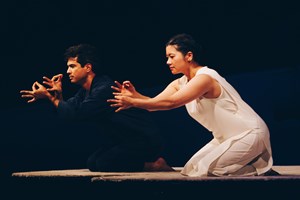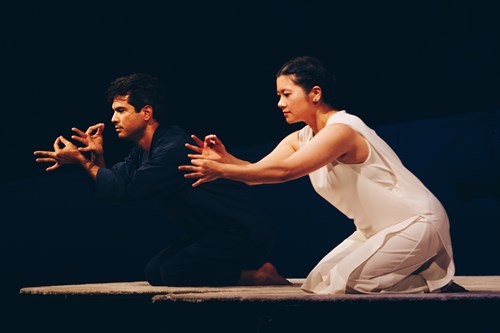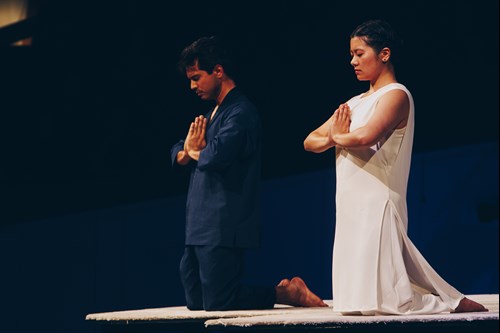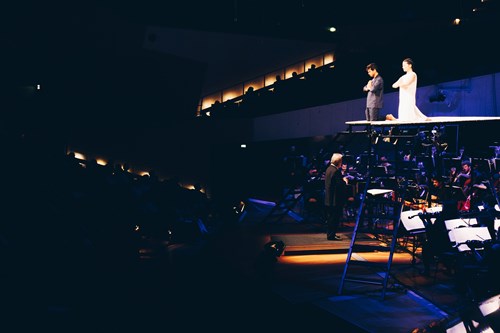
Inori, Japanese word meaning prayer, invocation, worship, was written in 1973-74 by Karlheinz Stockhausen and was performed many times in concert halls and theatres with orchestra (or tape) accompanied by one, two or three dancers since its premiere at the Donaueschinger Musiktage on the 18th October 1974. This time, shown at the Berliner Philarmonie, Inori was directed by Peter Eötvös.
Image: Inori prayer gestures
Inori, Japanese word meaning prayer, invocation, worship, was written in 1973-74 by Karlheinz Stockhausen and was performed many times in concert halls and theatres with orchestra (or tape) accompanied by one, two or three dancers since its premiere at the Donaueschinger Musiktage on the 18th October 1974. This time, shown at the Berliner Philarmonie, Inori was directed by Peter Eötvös.
Following the description of Stockhausen, the work is developed from a primordial formula that was composed first. It has 13 different pitches plus 2 which are repeated at their conclusion. The 13 pitches are associated with 13 tempos, 13 volumes, 13 sound strokes and 13 prayer gestures plus two final gestures. The primal figure has five members, which are separated by echoes and pauses. It lasts approximately one minute in its original form. The large form is in all dimensions and proportions a projection of the original form for a period of about an hour. The five limbs correspond in the large form five sections, which last about 12-15-6-9-18 minutes. In addition, a re-measured transcendental moment (in the section between spiral and adoration), pause and the long ending of the Indian bells.
 Inori prayer gestures
Inori prayer gestures
In the first section the rhythm is developed and performed, in the second section the volume, in the third section the melody, in the fourth the harmony and in the fifth the polyphony. So the whole work evolves like a history of music from its beginnings until today. In the rhythmic development, individual durations of the primordial figure gradually begin to pulsate, and each duration gets its own pace, tone and prayer gesture change with each tempo. At first, therefore, they serve exclusively for the rhythmic development and become very independent only in the course of the work in many places. The development of volume levels and volume curves for each time period is based on volume scales. These scales have 60 volume scales. These scales have 60 volume levels between extremely quiet and extremely loud. The grades are distinguished by the fact that one tone is played by several different instruments simultaneously.
 Inori prayer gestures
Inori prayer gestures
The prayer gestures are performed synchronously with the orchestra (tape) by two dancers miming on a podium in the middle. A gesture towardsthe heart in front of the chest with closed hands corresponds to the mean pitch G, the volume pianissimo and the longest duration. If this gesture is carried forward, away from the body, this corresponds to a crescendo from pianissimo to forte-fortissimo, which can be divided into 60 grades.
When the hands raise or lower, it is the same as the changes in pitch, and these vertical changes in the prayer gestures are classified as a chromatic pitch within three octaves.
When hands and arms spread out to right and left to step in steps, that corresponds to a series of regularly shortening durations. The different prayer gestures are used like sound tones and tempi. Through this close connection between gestures of prayer and musical stages and intervals, as the duration of the work increases, purely musical changes are experienced as prayer.
 Inori Performed in Berliner Philarmonie
Inori Performed in Berliner Philarmonie
The accuracy of the mimi dancers, Winnie Huang and Diego Vásquez, in their precise capacity of being totally synchronised with the music oeuvre, is fascinating and remarkable. Gestures recall the sacredness of certain movements in their efficiency and intrinsic meaning. Listening to the Inori composition and admiring the strong presence of the two performers, it is possible to undertake a journey of listening and reception where the space-temporality of the moment is canceled. Pauses and intervals in the musical composition as in the body representation sink into a marine reality, as if it were possible to experiment two dimensions at the same time, on the surface and immersed.
The Hungarian composer, with great abilities, guides the musical ensemble making a certain pathos vibrate inside the enveloping Philarmonie which remains an extraordinary space to listen and enjoy great masterpieces.

ArtDependence Magazine is an international magazine covering all spheres of contemporary art, as well as modern and classical art.
ArtDependence features the latest art news, highlighting interviews with today’s most influential artists, galleries, curators, collectors, fair directors and individuals at the axis of the arts.
The magazine also covers series of articles and reviews on critical art events, new publications and other foremost happenings in the art world.
If you would like to submit events or editorial content to ArtDependence Magazine, please feel free to reach the magazine via the contact page.